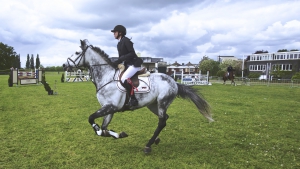After weeks of searching, you have finally found the right horse. He’s everything you’ve ever wanted. What now?
A veterinary pre-purchase exam should be the next thing on your mind! At a minimum, an active and passive exam by an equine veterinarian should be performed prior to purchase, but what about additional diagnostic imaging? Regardless of whether or not you’re buying your next equine athlete or your trail partner for the next twenty years, radiographs and ultrasound imaging may be in your best interest to protect your investment.
The Right Horse is the Right Horse For You
In all the pre-purchase exams we’ve performed, we have yet to find a “perfect” horse, and a horse that may be right for your goals, might not be the right horse for someone else’s.
It is important to remember that it is not the responsibility of the veterinarian to “pass” or “fail” a horse. What you should really be asking is, can you and your horse live with the faults identified during the exam and the limitations that arise because of those shortcomings? We are there to provide you, the buyer, with information pertinent to the health and soundness of this horse so you may decide how the horse may fit in your life and barn.
In some situations, it’s easy to determine whether or not the horse in question will stand up to his intended purpose. In other situations, we must rely on additional diagnostic means to answer these questions, thus enabling you to make a more informed decision.
When Should You Get Digital Images?
 Let’s say that your veterinarian has completed the basic pre-purchase exam and that a few issues have been discovered that require additional consideration. You may decide that the findings are small enough that they don’t impede your future plans with this horse, in which case the exam may not need to go any further. However, you might decide that the findings could deter you from purchasing the horse. This is when we would recommend further diagnostics in the way of nerve blocks, in addition to radiographs and possibly ultrasound.
Let’s say that your veterinarian has completed the basic pre-purchase exam and that a few issues have been discovered that require additional consideration. You may decide that the findings are small enough that they don’t impede your future plans with this horse, in which case the exam may not need to go any further. However, you might decide that the findings could deter you from purchasing the horse. This is when we would recommend further diagnostics in the way of nerve blocks, in addition to radiographs and possibly ultrasound.
Ultrasound technology is far more portable and convenient to use stall side than it was even just a few years ago. If there is any palpable soft tissue issue, but no lameness is detected on exam, then a scan is completely justifiable, especially if the horse is responsive to palpation of the area. Ultrasound can help us to see issues of the past and try to understand if they could become an issue in the future.
Similarly, radiology (x-ray images), are often the quickest way for us to understand a mild lameness that is identified in the dynamic portion of the exam. Technology these days enables us to develop radiographs within seconds as they appear on a computer screen. We may determine that there is a mild amount of arthritis in a specific joint or that this horse has significant degenerative changes that may impact his ability to perform as desired, or as long as desired. Radiographs, and digital/stall side images are the best way to differentiate between the two.
While forecasting the future is always the most difficult part of the pre-purchase exam, advanced diagnostic imaging can make that picture just a little clearer! A complete exam, and imaging to help understand any issues uncovered, is our best shot as veterinarians to help you, the buyer, and make sure this new horse is truly the “right one for you!”
complete exam, and imaging to help understand any issues uncovered, is our best shot as veterinarians to help you, the buyer, and make sure this new horse is truly the “right one for you!”




